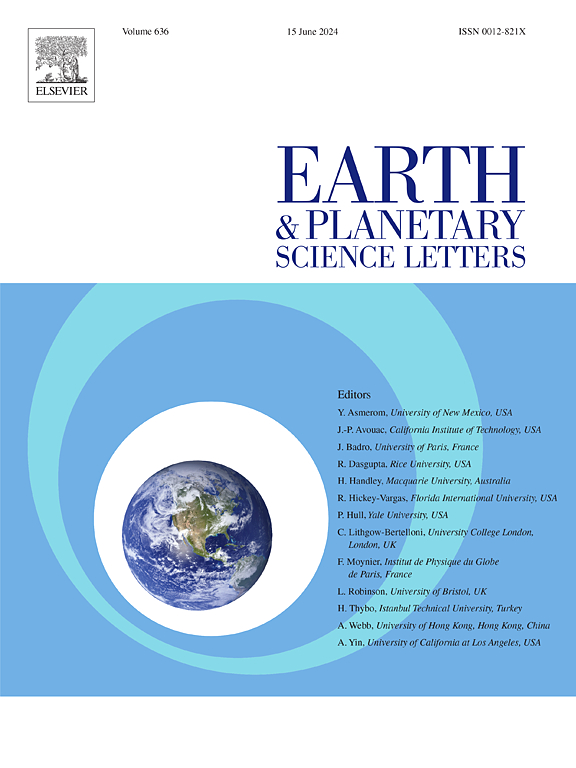中国西部地下地幔过渡带的接收函数图像:破碎俯冲与逆流上涌
IF 4.8
1区 地球科学
Q1 GEOCHEMISTRY & GEOPHYSICS
引用次数: 0
摘要
通过对接收函数进行变分半径叠加,得到了中国西部及邻近地区地下地幔过渡带(MTZ)的统一图像。我们利用了来自 1,991 个宽带地震台站的 218,050 个接收函数的大型数据集。经过三维速度校正后,我们的结果显示 410 公里和 660 公里不连续面的地形和 MTZ 厚度存在显著的横向变化。观测到的MTZ横向变化与独立层析成像研究中发现的地震速度异常相关,这些异常被解释为分别来自岩石圈下沉和地幔上涌的冷热异常。在青藏高原南部,地幔区地形显示出四个分段带,自西向东,地幔区厚度比平均厚度厚达20千米,与薄至正常的地幔区相互交错。这些分段的MTZ增厚可能源于一系列与印度岩石圈碎裂俯冲有关的冷岩石圈指,而薄至正常的MTZ可能源于没有俯冲的印度板块。这些观测结果为印度俯冲的碎裂提供了新的证据。此外,我们还在天山造山带和柴达木地块下观察到增厚的MTZ区域,这可能是准噶尔地块和塔里木地块下推引发的冷脱层/断裂岩石圈地块的创始。此外,在天山地区下方还观测到了变薄的MTZ区域,这可能是逆流上涌造成的。本文章由计算机程序翻译,如有差异,请以英文原文为准。
Receiver function image of the mantle transition zone beneath western China: Fragmented subduction and counterflow upwelling
A uniform image of the mantle transition zone (MTZ) beneath western China and neighboring regions is produced through Variable Bin Radius Stacking of receiver functions. We utilized a large data set of 218,050 receiver functions from 1,991 broadband seismic stations. Our results, after 3-D velocity corrections, show significant lateral variations in topography of the 410- and 660-km discontinuity and thickness of the MTZ. The observed lateral variations of the MTZ correlate with seismic-velocity anomalies identified in independent tomographic studies, which are interpreted as cold and hot thermal anomalies from lithospheric downwellings and mantle upwellings, respectively. In the southern Tibetan Plateau, the MTZ topography reveals four segmented zones of up to ∼20 km thicker-than-average MTZ from west to east interfingered with regions of thin-to-normal MTZ. These segmented MTZ thickenings likely originate from a series of cold lithospheric fingers associated with the fragmented subduction of the Indian lithosphere, while the thin-to-normal MTZ may result from an absence of the subducting Indian slab. These observations provide novel evidence for the proposed fragmentation of the Indian subduction. Moreover, we observe regions of thickened MTZ under the Tien Shan orogen and the Qaidam block, which likely result from the foundering of cold delaminated/broken-off lithospheric blocks triggered by the underthrusting of the Junggar and Tarim blocks. Regions of thinned MTZ beneath the Tien Shan region are additionally observed, which could be attributed to counterflow upwellings.
求助全文
通过发布文献求助,成功后即可免费获取论文全文。
去求助
来源期刊

Earth and Planetary Science Letters
地学-地球化学与地球物理
CiteScore
10.30
自引率
5.70%
发文量
475
审稿时长
2.8 months
期刊介绍:
Earth and Planetary Science Letters (EPSL) is a leading journal for researchers across the entire Earth and planetary sciences community. It publishes concise, exciting, high-impact articles ("Letters") of broad interest. Its focus is on physical and chemical processes, the evolution and general properties of the Earth and planets - from their deep interiors to their atmospheres. EPSL also includes a Frontiers section, featuring invited high-profile synthesis articles by leading experts on timely topics to bring cutting-edge research to the wider community.
 求助内容:
求助内容: 应助结果提醒方式:
应助结果提醒方式:


